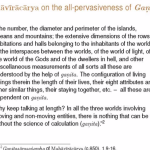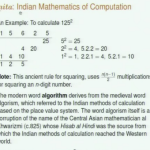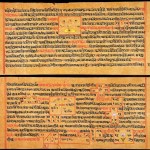This is the first of a 3-part set of Posts that follows our ‘Introduction to Ganita’

Topic Outline
This Post studies from an Indic perspective, the path taken by Mathematics from ancient Greece to reach its present form. We compare and contrast Math with Ganita (introduced in our previous post) and in this process, also gain a better appreciation for Ganita. In some places, oversimplifications are employed for ease of understanding, and to bring into focus certain latent aspects of the discourse. All emphases within quotes are ours.
For convenience, this Post has been divided into a set of three, to be published consecutively. The first part is presented today, but the entire set is previewed below:
Part 1: We study the origins and motivations of Math and the pivotal roles of Plato, Aristotle, and Euclid (via Elements) in shaping the initial course of Mathematics. We compare the Indian and Greek logic, noting the non-universality of logic. To each civilization and culture, their own: Pramana versus Proof. A fundamentally different understanding of the nature of ultimate reality guides the Math and Ganita approaches: The integral unity underlying Ganita versus a synthetic unity in which Math lives as a separately independent component.
Part 2: We observe and learn what happens when Ganita encountered Math. Sparks fly in a tussle between order and chaos when two sharply different approaches clash.
Part 3: We adopt an Indic civilizational perspective of the Math-Ganita encounters. This gives rise to interesting questions like ‘What was lost when Mathematics digested Ganita?’. We also look ahead, exploring the importance of Ganita and its Indian approach in a futuristic world.
Part 1:Introduction
Dolores Umbridge: It is the view of the Ministry that a theoretical knowledge will be sufficient to get you through your examinations, which after all, is what school is all about. Harry Potter: And how is theory supposed to prepare us for what's out there? (Harry Potter and the Order of the Phoenix, by J. K. Rowling).
Mathematics is the ‘science of learning’ that originated in ancient Greece, and comes from the Greek root mathesiz, or learning [1]. Plato’s Republic (~375 BCE) mentions the five specific disciplines of mathematics as: Arithmetic, Astronomy, Plane and Solid Geometry, and Harmonics [2]. Plato founded the Academy in Athens and gave Western (Greek) philosophy to the world. ‘Learning’ had a specific meaning in this philosophy. His ‘theory of recollection’ indicates that ‘mathesiz’ is all about a soul recollecting the knowledge it has forgotten. We cannot learn anything new, and only recall what we forgot [3]. His teacher was Socrates, and Aristotle was his famous pupil. Plato took as ideal that which was perfect, unchanging, abstract, even spiritual, and regarded the phenomenal world riddled with uncertainty as inferior. He favored the rational over the empirical, and the goal of uplifting the soul as superior to the task of performing mundane calculations. For example, when it came to arithmetic, his views as the narrator in the Republic were pretty clear [2]:
“I must add how charming the science of arithmetic is! and in how many ways it is a subtle and useful tool to achieve our purposes, if pursued in the spirit of a philosopher, and not of a shopkeeper!’
‘How do you mean?’, he asked.
‘I mean, as I was saying, that arithmetic has a very great and elevating effect, compelling the mind to reason about abstract number, and rebelling against the introduction of visible or tangible objects into the argument.”
Several elegant results came out this Greek approach which can be broadly viewed as a sequence of axiom/model followed by the use of deductive logic to prove an infallible theorem [5]. The exemplar for this approach is Elements, the treatise on geometry attributed to Euclid (~300 BCE), and this ancient work played a very powerful role in shaping the course of Mathematics. The impact of Euclidean geometry is visible to this day. However, progress in the realm of practical application and calculation was curtailed by the downgrading or even the elimination of the empirical. While logic and deductive reasoning are indispensable in detecting inconsistencies in arguments and help in viewing existing ideas more clearly, scholars have recognized the limitations of logic when it comes to understanding the nature of ultimate reality:
- Logic can be misused when it is employed to find Truth. About Aristotle [6]: “it was, for him, a tool for finding truth, but it didn’t keep him from making the most profound errors of thought. Nearly every argument and conclusion he made about physical science was wrong and misguided. Any tool can be misused, and in these pre-scientific days logic was misused repeatedly“.
- Deductive reasoning can help us analyze existing ideas better and lead us to a different way of tackling a problem, but in itself cannot lead us to new knowledge. “deduced conclusions are just restatements and repackaging of the content contained in the premises. The conclusions may look new to us, because we hadn’t thought through the logic, but they contain no more than the information contained in the premises. They are just cast in new form, a form that may seem to give us new insight and suggest new applications, but in fact no new information or truths are generated. This is especially noticeable in mathematics…“[6].
This Mathematics lived in an abstract infallible world divorced from reality. One cannot also overemphasize the impact of Aristotle’s ‘law of the excluded middle’ on western thought – a law that leaves no room for uncertainty. The intellectual ideas of Greece were eventually digested [4] into Christianity via the so-called ‘Hellenic-Hebraic’ synthesis. This should come as no surprise given the motivation for the studying mathematics included ideas of absolute perfection and ‘uplifting of the soul’. Mathematics thus became intertwined with the theology of an organized religion. A comparative study of the Indian and the Greek approach bring out the sharp differences between the Ganita and the Mathesiz approaches. Ganita, the integral science of computing, is not the same as mathematics. Unlike the five categories of Mathematics laid out by Plato, Ganita is all pervasive.
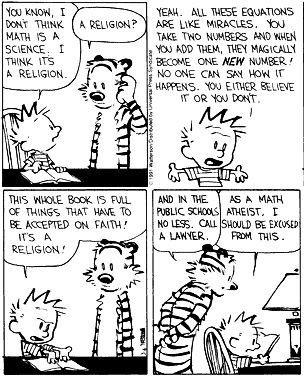
In [4], Rajiv Malhotra comments on the influence of Aristotle on western thought: “The Law of the Excluded Middle dictates that the principle ‘P or not-P’ separates one thing from another in an absolute sense. All physical and logical entities are invariant units, mutually exclusive of each other. This is not just a pragmatic criterion for distinguishing one thing from another; it is the very nature of reality in both concrete and abstract realms. The law eliminates the possibility of things being mutually dependent, interrelated and interpenetrated. It is diametrically opposed to the intertwined and fluid relationships characteristic of integral unity…”.
There appears to have existed a state of tension between the fallible-and-real and the infallible-and-perfect domain in the western thought since the time of Plato, which manifests itself today as the anxiety-filled binary of ‘religion versus science’. Since this gap was never breached, only a synthetic unity was ever possible [4], and the resultant western approach is reductionist. The independent parts have to be subsequently synthesized to achieve unity. For example, we read in [25] that “much of Western civilization is based on separating the parts. One date is separate from another, history separate from math which is separate from biology. It’s a world view we inherited from Newton and Descartes, so useful in many ways and disastrous in others. However, there has always been an alternative view of the universe as a single, totally interconnected system. You’ll find that in Eastern traditions.“. To this day, Mathematics and Science are treated and taught as two different school subjects. A key tussle here is between the ‘lower’ empirical world we can experience, and the ‘higher’ abstract-theoretical domain, with the latter being considered superior. This western view is even being taken as the universal approach to knowledge.
Western Universalism
Today, we can observe the promotion of the notion of a western universalism that traces its origin to the intellectual tradition of ancient Europe. For example, the choice of the logo for UNESCO, a world body, reflects a desire to preserve the memory of Parthenon in ancient Greece, which was damaged in wars eons ago. Key buildings in several prominent universities in the United States are designed to remind viewers of the glory of ancient Rome and Greece.
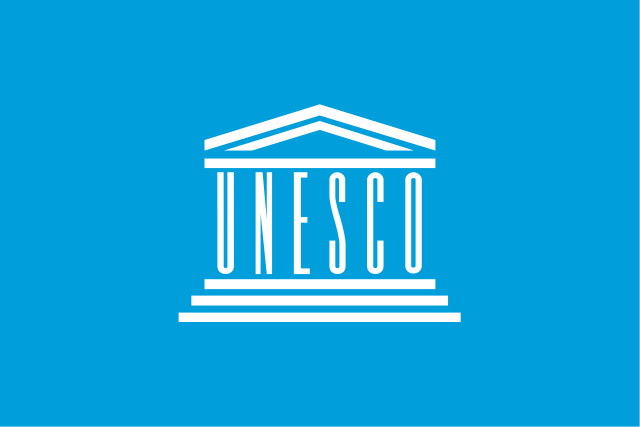
The belief in the dominance of Euclidean Mathematics is reflected in the argument between the ancient Greeks and Epicureans.
The Epicurean Ass
The Epicureans opposed the followers of Euclid who, from their perspective, appeared to be proving obvious results. For example, consider the following proposition in Elements as discussed in [23]:
“Any two sides of a triangle are together greater than the remaining side.
In other words, a straight line is the shortest distance between two points!
If anyone wanted to ridicule mathematics for its insistence on the axiomatic method of orderly proof, this theorem offers a wide target. In fact, the Epicureans (those Athenian free-thinkers, who defined philosophy as the art of making life happy) did exactly that. They said that this theorem required no proof, and was known even to an ass. For if hay were placed at one vertex, they argued, and an ass at another, the poor dumb animal would not travel two sides of the triangle to get his food, but only the one side which separated them.”
C. K. Raju explains both sides of the argument [7]: “Proclus replied that the ass only knew that the theorem was true, he did not know why it was true. The Epicurean response to Proclus has, unfortunately, not been well documented. The Epicureans presumably objected that mathematics could not hope to explain why the theorem was true, since mathematics was ignorant of its own principles..” In the end, the Greek response cites the authority of Plato that mathematics “takes its principles from the highest sciences and, holding them without demonstration, demonstrates their consequences.“ [7].
Let us now introduce an Indic perspective.
In contrast with this Greek view, all Indian schools of thought accept empirical means of verification (e.g., pratyaksha pramana [1, 22]) while acknowledging the potential fallibility. All darshanas would reject any axiomatic approach that lacked valid pramana. The use of empirical rationale has existed in India since ancient times, including the Sulba Sutras (800 BCE or earlier) and is different from the axiom-theorem approach. C. K. Raju puts this in perspective: “Because no proof was stated it does not, of course, follow that the authors of the sulba sutras did not know why the result was true. But the method of proof that convinced them may well have differed from the current definition of proof. Thus, it is incorrect to assert that the constructional methods used in the sulba-sutras implicitly lead to a proof in a formalistic sense. It is incorrect because the rationale for the formula for a right-angled triangle, from the constructional methods of the sulba-sutras right down to the 16th century Yuktibhasa, explicitly appeals to the empirical“. [7]
The Epicurean Ass argument has been kept alive in some form or the other to this day in a western worldview. From an Indian point of view, a Ganita expert like Srinivasa Ramanujan too was deemed a ‘wizard’ [14, Lecture 1] who did not know why his results were true, despite his point that he employed his own valid method, which produced so many astounding new and true results. He had to move from Kumbakonam to work in the U.K. to prove his results to the satisfaction of the formal math community in order to gain acceptance.
Indian Gurus, Yogis, Siddhas, and Tantriks who, through years of practice and sadhana, demonstrated amazing results in transcendental meditation, mind sciences, and medical sciences are sometimes labeled pre-rational Indian ‘mystics’ [4] as opposed to western ‘scientists’ who came up with sophisticated instrumentation that subsequently confirmed these results. Universities like Harvard periodically comes out with a research report ‘proving‘ prior findings in Yoga and Ayurveda from the Dharma traditions, which have been practically employed for centuries.
Public intellectuals like Rajiv Malhotra also ask: How often are these Hindu and Buddhist monks, who are the primary producers of this knowledge, credited as co-authors in the journal papers? This bias is propagated subtly by western scholars who study Hinduism. For example, Phil Goldberg who teaches at Loyola Marmount University, an institution rooted in the Jesuit Catholic tradition, compares ‘Indian philosophy and Western science’ in [8]. He also endorses the rejection of the ‘orange’ [saffron] robe of Dharma in favor of the authoritative western scientific garb of a ‘white lab coat’ in order to increase the credibility of Yoga and meditation techniques in the minds of westerners. Note the approach is one of extracting the benefits, and then rejecting/denigrating the Dharma source. Such biased attitudes have also helped feed an increasing Hinduphobia within western academia.
Two-valued logic is not universal. India had not one but several different schools of thought that also studied logic [22], including Nyaya and Navya Nyaya, as well the Buddhist Catuskoti, and Jaina Syadavada. In fact, the Buddhist understanding of integral unity as encapsulated in Nagarjuna’s brilliant arguments has been recognized as nothing short of a “death-blow to all synthetic unities that start with different essences and then look for unity” [4].
Indian Logic vs Greek Logic
There are several papers available that discuss the Indian approach to logic. For example see this work of Subhash Kak [9] and this discussion of Indian and Greek logic. In the popular textbook example for Indian syllogism versus that of Aristotelian logic, the first thing we notice are the ‘five steps’ in the Indian approach versus three in the Greek template [22]. The steps in the Indian rules of inference are not redundant and serve as a reality-check based on the correspondence principle of Bandhu [9], whereas the Greek argument is restricted to the infallible abstract domain. As Roddam Narasimha notes in [5] where he compares Greek Axiomatism and Indian Computational Positivism, the Indian distrust of deduction-based logic “appears to have been based on the conviction that the process of finding good axioms was a dubious enterprise. Note that logic in itself was not something that was shunned in India; without going into a detailed discussion of Indian systems of logic, it is enough to note here that time and again Indians use deductive logic to demonstrate inconsistencies or to refute the positions of an adversary in debate, rather than to derive what western cultures have long sought through that method – namely, certain truth.“.
The intellectual prowess of the ‘deductive logician’ has been promoted in popular western culture. For example, Sherlock Holmes is recognized foremost for his superb deductive reasoning, and is considered the most portrayed literary human character in history. However, an analysis of his stories show that Holmes relied a lot on anumana (inference) including the so-called abductive and inductive methods, and Conan Doyle did consider Holmes’ methods to be fallible, which resembles a Ganita approach to sleuthing!
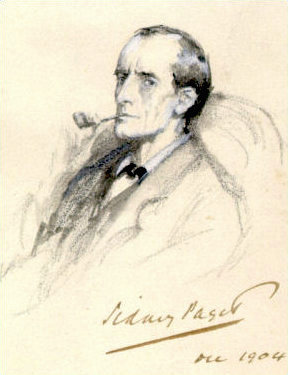
CK Raju [1] calls out some flaws in the claim to universality of two-valued logic. First, the Hindu darshanas, Buddhist Catuskoti, and Jaina Syadavada offer solid alternatives from a different culture. These alternatives have always been compatible with the latest developments in science at every point in time, including Quantum Mechanics. We do not find any serious ‘religion vs science’ problem in India [4]. Even the materialist Charvaka school would reject this reductive logic for not accepting a Pratyaksha Pramana [1, 22]. Finally, it is tough to justify two-valued logic citing empirical evidence if its claim to dominance lies in its empiricism-free perfection [1].
A remaining argument in favor of a universality of two-valued logic and axiomatism is the endorsement by ‘higher authority’, representing a distorted version of Sabda pramana [22]. Indeed some proofs published in journals today are so abstract and technical that they can only be decoded by top formal mathematicians. The remainder of the global math community take it as truth based on the verbal authority of an elite few.
Mathematics may be defined as the subject in which we never know what we are talking about, nor whether what we are saying is true - Bertrand Russell.
Vignette: Demotion of a Theorem
In middle school geometry, we learn about the congruence of triangles and come across the side-angle-side (SAS) postulate [23]:
“The fundamental condition for congruence is that two sides and the included angle of one triangle be equal to two sides and the included angle of the other.”
This result can be easily verified using empirical rationale (proof-by-superposition, as Euclid himself did), and would be perfectly acceptable in Ganita, but not in mathematics. This is because superposition involves moving one triangle and placing it on top of the other, which is considered a ‘fallible’ process. The SAS result is difficult to prove using logic alone and thus the SAS theorem was demoted to the status of an unproven postulate.
We conclude Part 1 by delineating a key, irreconcilable difference between Ganita and Mathematics. This difference also manifests in virtually every other field of study.
Summary: Fundamental Difference between Ganita & Mathematics
The ancient Indians recognized Nyaya (logic) and employed Tarka (reasoning) and even mastered it, but did not put it on a pedestal because of certain limitations. Results in Ganita, like all other Indian disciplines, are tied to a valid Pramana and rooted in reality, rather than an axiom-based proof operating in a separate abstract domain. The empirical approach can elevate the practitioner to a higher state of consciousness (The Bhagavad Gita recognizes it as a valid way to transcendental knowledge [4]).
Subhash Kak summarizes the Indian approach to acquiring knowledge based on bandhus [9]: “The universe is viewed as three regions of earth, space, and sky which in the human being are mirrored in the physical body, the breath, and mind. The processes in the sky, on earth, and within the mind are taken to be connected. The universe is mirrored in the cognitive system, leading to the idea that introspection can yield knowledge“. It is worth repeating what has been said before: In nature, the western civilization is intellectual, the Chinese civilization is philosophical, and the Indian civilization is spiritual (adhyatmic).
Ganita is rooted in an integral unity whereas Mathematics exists as a separately independent part of a synthetic unity.
This integral approach produced some of the most important contributions, from Hindu numerals, place value system with zero, to symbolic language for managing equations [5] and calculus. On the other hand, the abstract nature of Mathematics resulted in a drastically reduced practical output while Europe drifted into a 1000+ year Dark Age. During this entire period, Ganita contributions from all Dharma thought systems proved to be crucial in keeping mathematics practically relevant in other parts of the world, up to the 17-18th century CE. We discuss these Ganita-Math encounters in the upcoming second part of this set of Posts.
Selected References
- Cultural foundations of mathematics: the nature of mathematical proof and the transmission of the calculus from India to Europe in the 16th c. CE, C. K. Raju. Pearson Longman, 2007.
- Plato on Mathematics. MacTutor History of Mathematics archive. 2007.
- Plato’s Theory of Recollection. Uploaded by Lorenzo Colombani. Academia.edu. 2013.
- Being Different: An Indian Challenge to Western Universalism. Rajiv Malhotra. Harper Collins. 2011.
- Axiomatism and Computational Positivism: Two Mathematical Cultures in Pursuit of Exact Sciences. Roddam Narasimha. Reprinted from Economic and Political Weekly, 2003.
- Use and Misues of Logic. Donald Simanek. 1997.
- Computers, mathematics education, and the alternative epistemology of the calculus in the Yuktibhasa. C. K. Raju. 2001.
- American Veda: From Emerson and the Beatles to Yoga and Meditation How Indian Spirituality Changed the West. Phil Goldberg. Random House LLC. 2010.
- Logic in Indian Thought. Subhash Kak.
(The complete list of references will be published along with part 3).
Acknowledgments: I would like to thank the ICP bloggers for their constructive feedback and the editor for his incisive comments and ideas.
